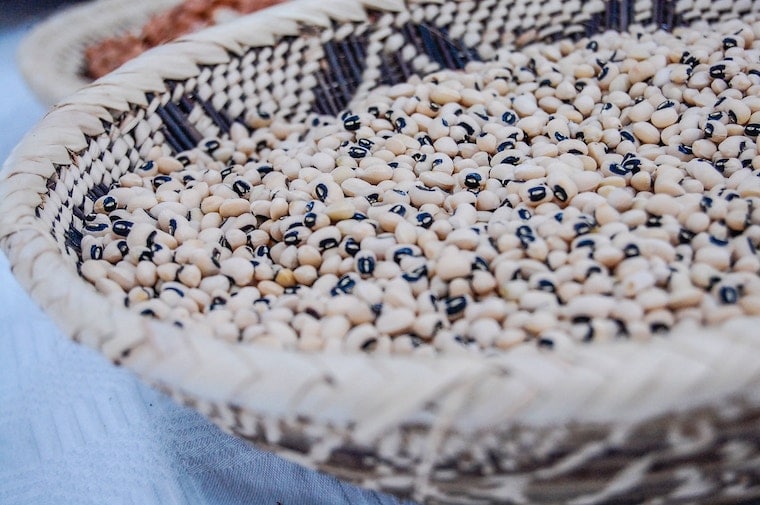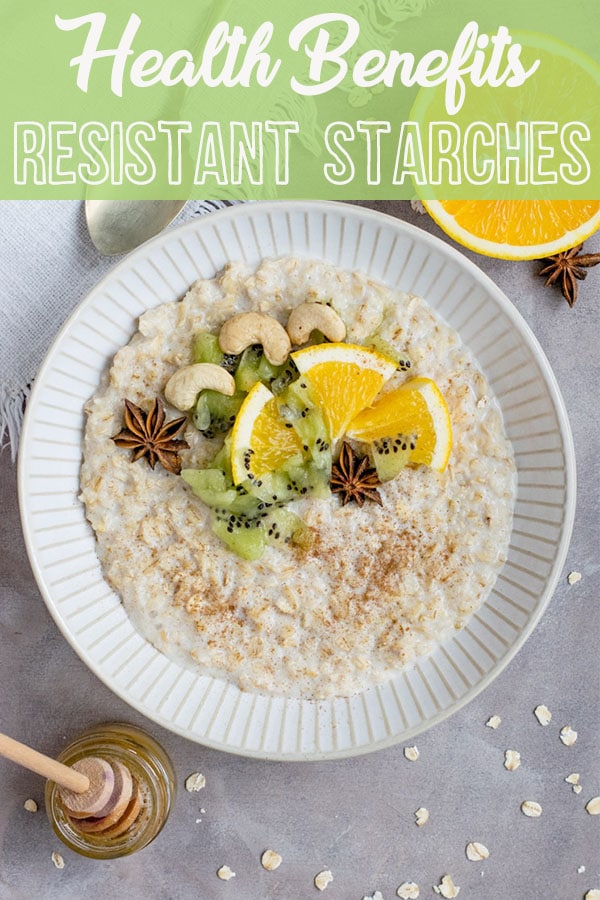I share with you everything you need to know about resistant starches. What they are, what types exist, and their health benefits.
Click here to read PART 2 of this resistant starch series on the role of cooking resistant starches and weight loss and health benefits.
What do you think of when you hear the word “resistant starch”? Maybe you think about unripe, green bananas or maybe you’ve heard about it as a “weight loss superfood” claiming to shed off the pounds. Maybe you don’t think of anything because this is all news to you. Regardless of where your starting, let’s first find out what a resistant starch is and whether it lives up to its claims.
Resistant starches are a type of starch composed of long chains of glucose units that aren’t fully broken down and absorbed. Resistant starches are unique because common starches are broken down in the body into glucose and then absorbed, which increases our blood glucose, however this does not occur with resistant starches.
Dietary Sources of Starchy Foods High in Resistant Starches
- Roots and Tubers (e.g potatoes, yams)
- Green bananas
- Legumes (e.g chickpeas, lentils, beans)
- Grains (e.g oats, rice, sorghum, buckwheat, barley)
So are resistant starches a carbohydrate or a type of fiber? Actually, resistant starches are classified as both. A portion of the starch cannot be digested which makes it digestion-resistant. Since the starch is not broken down, it passes from the stomach to the large intestines (colon). Once it reaches the large intestine, our gut bacteria are capable of using it as a fuel source making resistant starches an excellent source of prebiotics. As we’ve already learned about probiotic and prebiotics, healthy gut bacteria can do wonders for us.
Types of Resistant Starches
Surprisingly, there are actually FIVE different types of resistant starches, including inaccessible starch (outer barrier prevents digestion), granular starch (dehydrated and tightly-packed within starch), retrograded starch (ie digestible starch that’s been transformed into a “resistant form” from a “cooking and cooling process”), chemically-modified starch (man-made form), and the amylose-lipid complex (heat-stable starch coated with fat). These 5 types of resistance starch are classified based on how they cause “enzyme resistance”, or in other words, how well they resist being broken down by enzymes. However, more than 1 type of resistant starch can be found within the same food. Now that we have an idea of different types of resistant starch, let’s find out if resistant starches carry any health benefits.
Health Benefits of Resistant Starches
The large body of evidence on resistant starch content in our foods supports a number of important health benefits. Since it is not digested in our small intestine and used by the body, it is available for gut bacteria in the large intestine to utilize. Research suggests that the 6 grams of resistant starch per meal is the minimum amount providing health benefits. However, there is definitely a need to unravel the potential effectiveness of digestion-resistant starches, particularly for its role in preventing and controlling various human diseases.
Let’s start with gut health.
Gut Health
Scientific evidence has shown that our gut bacteria can have fundamental health benefits for us, such as immunity, infection protection, and nutrient absorption. When our gut bacteria uses resistant starches as a fuel source in the large intestine, this promotes the production of short-chain fatty-acids (SCFA) such as butyrate, which is most valuable for humans because it is the preferred source of energy for cells of the large intestine. Research has also demonstrated that the way you prepare high starch foods such as rice, potatoes, and pastas can change their resistant starch content. Studies propose that SCFA provides important physical AND mental health benefits associated with regulating macronutrient metabolism, influencing hormone-secretion and reducing precursors involved in colon cancer development.
Studies performed on humans who consumed high resistant starch diets revealed changes to the quantity and functionality of important bacteria. Other studies have indicated that fermentation of resistant starch in the large intestine leads to higher probiotic concentrations, which are crucial microorganisms linked to many health benefits and reductions in bad bacteria.
Colon Health
Resistant starch potentially reduces inflammation within the body and may effectively alter bacteria metabolism found in your intestines. Recent findings have shown that resistant starch may have promising effects for preventing and treating gastrointestinal health issues including colon cancer and inflammatory bowel disease (IBD). Researchers also suggest that resistant starch may be important for treating other cancer forms such as breast cancer because of its systemic effects impacting the entire body. Although there are a lot of experiments performed on animals which revealed significant improvements in bowel function, there were mixed outcomes for human studies. Findings in a systematic review and meta-analysis of randomized controlled trials involving healthy adults, suggested that there were overall beneficial effects for the large intestine when healthy adults were supplemented with resistant starch. Butyrate, which I mentioned earlier, is actually the preferred direct source of fuel for the cells lining your colon. Dietary sources of butyrate include milk from ruminant animals including cows (i.e. dairy milk), butter and cheese. However, eating high fiber foods such as vegetables, fruits and legumes, allows gut bacteria to ferment the fiber and synthesize SCFAs like butyrate. Cell culture experiments suggest that butyrate has anti-tumor growth properties, but whether this can be replicated in humans is unclear. Since therapeutic effects of resistant starch on the colon have been suggested by numerous studies, it may be effective for other digestion-related disorders such as inflammatory bowel diseases, constipation, diverticulitis and diarrhea. More controlled human trials must be performed before making any recommendations regarding its colon health benefits.
Insulin, Diabetes Management and Blood Sugar Levels
A large body of research has extensively studied benefits of resistant starch for metabolic health. Recent animal studies and clinical trials on humans have indicated that the benefits of resistant starches may be used for improving metabolic features and manage metabolic diseases.
Studies have shown the beneficial effects of resistant starch for improvements in insulin sensitivity among both healthy individuals and those with metabolic syndrome. Research has shown that consuming 15-30 grams daily resulted in a 33-50% improvement in insulin sensitivity among men and women.
In terms of its effects on well-controlled type 2 diabetes, a study involving daily ingestion of 40 g of type 2 resistant starch for 12 weeks demonstrated significant reductions in glucose concentrations after meals, and a tendency for higher uptake of glucose. Future research needs to confirm the health benefits of resistant starch for humans meeting dietary fiber requirements.
In both animal and human research, resistant starch consumption has shown to improve glycemic control. These studies have shown that after consuming retrograded (cooked-cooled/type 3 resistant starch) foods, there was a prolonged and slower increase in blood glucose levels in humans. Therefore, there may be benefits when replacing regular, digestible starches with resistant starch for lowering glucose concentrations and the insulin response after consumption.
What’s more interesting is the certain phenomena known as the “second meal effect”, in which incorporation of resistant starch in the first meal reduced blood sugar levels (and glycemic response) after consuming the next meal (i.e. after breakfast, it’d be lunch). Healthy participants consuming a high-amylose starch for breakfast, rather than a high-amylopectin starch, displayed a decreased blood glucose response to a lunch consisting of a highly digestible carbohydrate. Despite the small sample size, researchers indicated that resistant starch may be advantageous for diabetes management. In a randomized cross-over study, the effects of 2 fermentable fiber types on postprandial SCFA production and glycemic response of the second-meal was compared in healthy overweight or obese and lean subjects. Results showed reduced levels of insulin and glucose responses from the second-meal.
A long-term lifestyle and dietary intervention performed on obese prediabetic adult men and women, showed that a diet rich in resistant starch from ordinary food sources did not alter glycemic control compared to a regular high-fiber (over 25 g/day) diet, however, the high resistant-starch diet group did see a greater decreased total and non-HDL cholesterol compared to the fiber-diet group, whereas the fiber group displayed improvements in blood sugar levels. It seems then that it’s both the total and the type of fibre that matters.
Weight Management
Main factors supporting the potential positive benefits for weight management from high resistant starch diets include its low calorie-content, its ability to increase feelings of fullness and increase fat oxidation.
Low-Calorie Content
With the health benefits of dietary fiber, some propose that increasing resistant starch in your diet can be used as a new and effective strategy for reducing energy intake. This is because increased consumption of fiber has been associated with lower BMI and increased satiety. In comparison to regular starch, resistant starch is much lower in calorie content since it is indigestible and classified as fiber. That’s why replacing rapidly digestible starch with resistant starch will decrease how many calories are in your diet which may result in weight loss.
Appetite Regulation
Resistant starch research has proposed that appetite regulation may be another key benefit for aiding weight loss because of its influence on SCFA production. The amount of resistant starch available has major impacts on the population of gut bacteria and their production of various metabolites, especially SCFAs. The limited number of studies involving humans have provided very inconsistent results. For instance, when participants consumed muffins containing resistant starch for breakfast, there was increased and longer duration of satiety. To contrast this, in a randomized, single-blind, crossover study on healthy adults, replacing some of the standard wheat flour in muffins with resistant wheat starch, which was consumed at breakfast, did not lead to reduced appetite and food intake at the lunch meal. However, over the 24-hour period, muffins with resistant starch did lower insulin concentrations and total energy intakes.
Another recent study involving 25 g of resistant starch in a breakfast meal did not reveal any effects on subjective appetite OR food intake over the course of the day. Likewise, another randomized, single-blind, crossover study supplementing banana starch found no effect on gut satiety hormones or appetite. However, resistant banana starch did reduce food intakes; suggesting that supplementation may help with reducing portion sizes and weight control. There is still a ton of work to be done before we can recommend increasing resistant starch as an effective strategy for weight loss.
Fat Oxidation
Finally, another way resistant starch can influence body weight is by potentially increasing energy expenditure or fat oxidation. Some research suggests that replacing rapidly digestible starch with resistant starch increases mobilization of fat because of its effects on reducing the secretion of insulin, but there is way too little evidence in support of this hypothesis. Studies have also failed to show any increases in fat oxidation or energy usage. The effects of resistant starch on blood cholesterol levels, decreased formation of bile stones and enhanced mineral absorption are other health claims derived from rat studies which are still too preliminary for applications in humans.
Overall research on humans (healthy and insulin-resistant) suggest that resistant starch may not reduce total body weight and energy intakes. In humans, although resistant starch has shown to decrease blood glucose and increase insulin sensitivity, it seems to be ineffective for altering body fat or weight. Further human studies should be performed to understand the effects of chronic resistant starch consumption on obesity and various diseases.
Click here to read PART 2 of this resistant starch series on the role of cooking resistant starches and weight loss and health benefits.
Contribution By:
RD2B Rachel Shim
Updated on October 23rd, 2020

Abbey Sharp is a Registered Dietitian (RD), regulated by the Ontario College of Dietitians. She is a mom, YouTuber, Blogger, award winning cookbook author, media coach specializing in food and nutrition influencers, and a frequent contributor to national publications like Healthline and on national broadcast TV shows.













Horizon academy says
I liked this very much
John Graham says
Where is the recipe for that picture with the kiwi, orange and what I believe is star of anise maybe?
Thanks 🙂
Abbey Sharp says
Is this the one you’re thinking of? https://www.abbeyskitchen.com/vegan-turmeric-golden-milk-nice-cream-sundae/
deepika says
these benefits are very helpful
thank you for sharing
Abbey Sharp says
Thank you!
Parth Rathod says
Very helpful and nicely written
thank you for sharing
Abbey Sharp says
Thanks so much
Annmarie says
SO much great information! Definitely bookmarking to reference for later.
Abbey Sharp says
Amazing! Thanks love
Natalie says
Oh girl, you just gave me so much info. Thanks for this really good read.
Abbey Sharp says
Thanks so much Natalie 🙂
dixya @food, pleasure, and health says
as always such detailed and thorough post!
Abbey Sharp says
Thank you lovely
Summer Price says
You always have so much information to share I love it. You write it in an informative and not boring way too 😀 Always a plus! Thanks, Abbey.
Abbey Sharp says
Aw thanks so much love! Glad you enjoyed reading it
Farrah says
I’ve only kindasorta heard about the benefits of resistant starches, so it was awesome getting to learn more! :] Thanks for putting together this post! <3
Abbey Sharp says
Of course! Glad you liked it
Mikki says
Wow. What a great post! I had never really heard of resistant starches before. I enjoyed learning all the health benefits. Especially the gut! So much stems from what is going on in our gut!
Abbey Sharp says
Totally! Gut health is so fascinating
Rachel says
Fascinating, thank you! I didn’t know most of this.
Abbey Sharp says
Thank you!
Samantha says
This is so interesting! I’ve never heard of resistant starches! Great post 🙂
Abbey Sharp says
Glad you liked it! Thanks love